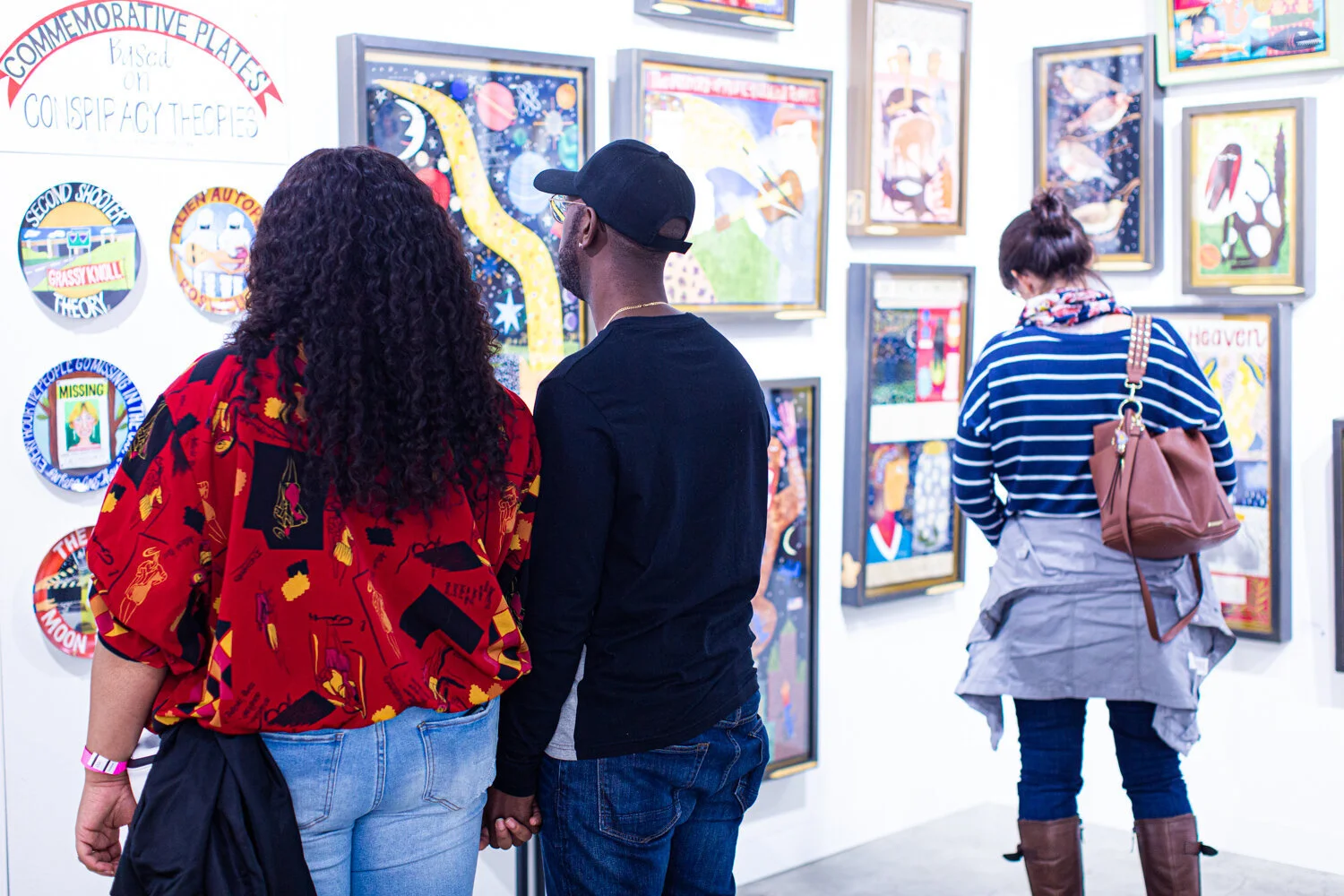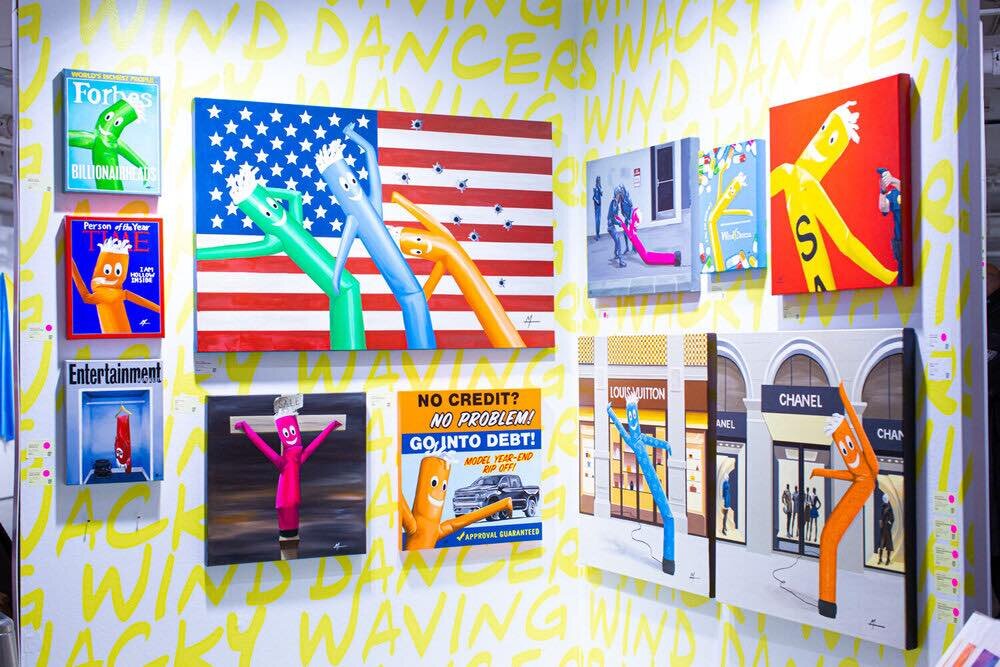9 Successful Vendor Booth Ideas To Capture Foot Traffic At An Art Fair
A Successful Vendor Booth Display At An Art Fair Can Help You Sell More Art.
* Updated December 2024
Though you might be inclined to think your art speaks for itself, your vendor booth at an art fair is the first impression visitors and potential art collectors will have of you.
There are a few tried and true formulas for setting up your vendor booth successfully, from eye-catching layouts, stand-out wall text and even making sure you and your space is approachable for visitors. Read on for our list of do’s and don’ts for setting up a successful vendor booth display!
Visitors at Superfine! LA 2020 discovering artwork in a successfully executed vendor booth.
Show your artwork off
If you’ve already been accepted to sell at a contemporary art fair, you can rest assured that your artwork is compelling enough to make a name for itself in the midst of other top exhibitors.
No matter how interesting or trendy your work may be, however, there’s always more you can do to attract foot traffic at an art fair. Even the most successful individual artists plan ahead, incorporating successful vendor booth ideas into their layout in order to draw in visitors to interact with their work – and make sales.
It’s a fact: the greater the number of people who have access to see your work, the more sales you’ll inevitably make. How do you guarantee that your vendor booth setup is attractive and user-friendly enough to maximize exposure?
Every individual artist who has exhibited at international art fairs or even local art shows has their list of do’s and don’ts for successful vendor booth ideas. Here are some of ours based not only on our observations from years in the business, but feedback from Superfine! exhibitors as well.
Mamie Young Art at Superfine! LA in February 2020.
The Do’s and Don’ts of successful vendor booth ideas
Do: Know your showstoppers. We all know the feeling of walking amidst the white wall forest of a contemporary art fair, the pieces and booths a blur until: something bold and entirely unique catches your eye. You might not even know why, but in that moment you must go look at it. Most artists will know right off the bat what their show-stopping piece is when preparing for an art show – do you? Having a few works that serve to show off your artistic style is guaranteed to turn heads.
Do: Plan your hang. Knowing what your showpieces are is great, especially if they are incorporated in a successful vendor booth hang. One exercise we have all exhibitors do when selling with us at a Superfine! Art fair for independent artists is to create a digital layout of their space, planning where they will hang the accepted works in the show. When you have a mockup complete with dimensions of your vendor booth space, you can successfully and accurately plan out where each piece will go and where it will look best. That way, you won’t have any hangups when it comes time to put your work on display.
Do: Think outside the walls. Your vendor booth display doesn’t stop where the walls meet the floor. Your body of work might include projections, decals, and installations – some of which may benefit from being displayed in three-dimensional spaces. Be wary of tripping hazards; the last thing you want at an art fair is a crowded booth where potential collectors are stumbling over difficult-to-see sculptures. If you do install a piece in an unexpected space, make sure it is properly marked or on a pedestal so that the space is denoted.
Do: Add your own personal flair. Some of our favorite ways exhibitors have shown off their personal flair span from printing their original artwork on cookies and chocolates to running social media contests. If you’re looking for a simpler way to start adding a personal touch to your vendor booth, try bringing in a bouquet of flowers with a color palette that compliments your artwork. These kinds of little touches are thoughtful, easy, and translate well. Think of them as a beacon for art fair attendees!
Do: Bring extra work. When you inevitably sell a work, you’ll want to place a coveted red dot on the label to signal your accolade. If a collector who missed out on an initial purchase expresses interest in a piece that has already sold, it’s helpful to have a comparable one in backstock to show to them. Some collectors may want to pay and take the work home with them on the same day, possibly even before the fair is over. Having options to fill in any blank spaces will make it easy to maintain a beautiful, attractive gallery wall hang and create an interesting vendor booth space at which people can look.
Don’t: Crowd the walls. Some artists may work in a crowded space as part of their concept, but chances are that’s not what you’re going for. Avoid the visually overwhelming effect overly-crowded gallery walls can create by paring back and giving your work enough room to breathe. This will not only be more visually pleasing, but will give foot traffic space and time to pause and contemplate your work.
Don’t: Brush off curation. Just as leading contemporary art fairs like Superfine! curate their exhibitor roster to a particular city and demographic, you (as the artist!) should pay special mind to the curation of work you bring to the show. Though you may have to submit photos of works or a proposal in advance for consideration, you should still put curating your space at the top of your priorities list. Successful vendor booths value a “quality over quantity” approach, as foot traffic and prospective collectors can sense right off the bat whether or not the work in your space is cohesive and well-executed.
Don’t: Crowd the space. It’s great when all your friends and family members show up to support you for your big art fair moment, but it’s not so great when there are so many people hanging out for long stretches of time that other attendees aren’t allowed the space to appreciate your work. There might be a few collectors in that crowd, and you don’t want to pass up any potential sales because your great aunt wants to catch up on opening night.
Don’t: Eat or read. Of course you can step out and grab lunch, but eating in your exhibitor space at a contemporary art fair is a red flag for foot traffic. It shows that you are not interested in interacting with anyone and basically insinuates that your booth has a “closed” sign on it. The same goes for reading – any activity that closes you off from interacting with foot traffic is a turnoff for foot traffic, as they’ll be distracted by your activity and most likely will not want to disturb you. If you need to take a break during long fair hours, have a friend or colleague come and relieve you for a break! That way, there will be someone in the space who is energized and can interact with any potential collector that comes your way.



